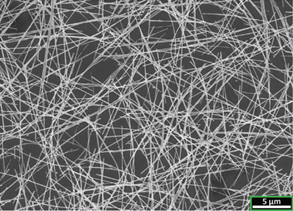Transparent conductive electrodes are of relevance for industrial applications such as solar cells, LEDs and touchscreens. These electrodes, however, are expensive and brittle by nature. The promising alternative are silver nanowire networks. Researchers from Eindhoven developed better ways to produce and characterize them.
Conventionally, transparent conductive electrodes are made of thin film conductive oxides, which consist of rare-earth materials. These materials are expensive. Besides that, the electrodes are brittle by nature and thus poorly suited for applications in flexible screens. Silver nanowire networks have great potential : they combine high conductivity with mechanical flexibility, low manufacturing cost and optical transparency. The first devices with silver nanowire electrodes are already on the market.
Researchers from DIFFER found a better way to produce silver nanowires. Together with colleagues of Eindhoven University of Technology (TU/e) they devised a new method to measure the quality of these silvery networks. PhD students Matteo Parente (DIFFER) and Niels van Hoof (TU/e) published their results in the scientific journal Advanced Optical Materials.

Synthesis of silver nanowires
Silver nanowires are usually prepared by the so-called polyol synthesis, a simple, fast and scalable process. ‘The main disadvantage of this synthesis is the high amount of by-products at the end of the process, which are detrimental for the performances of the electrodes,’ Parente explains. ‘In our group at DIFFER, we found a simple way to drastically minimize the amount of by-products at the end of the synthesis. This allowed us to produce very high quality transparent electrodes from silver nanowires.’
Non-contact measurements
The researchers from TU/e and DIFFER found a better way to measure the quality of the silver nanowires. Traditionally, this is done with a 4-point probe technique. This technique only gives a general overview of the properties of the sample. It damages the sample as well, sometimes. The researchers used two non-contact techniques to improve the measurements: terahertz time-domain spectroscopy (THz-TDS) and terahertz near-field microscopy. THz near-field microscopy can spot any defects of these conductive networks, even when they consist of a nanowire array .
Wearable electronics
Silver nanowire electrodes open to way to the cheap realization of wearable electronics, Parente foresees: ‘ Due to their low realization cost and versatility, silver nanowires networks can reduce the cost of the production of electronic devices with transparent electrodes.’
Publication
Terahertz Time‐Domain Spectroscopy and Near‐Field Microscopy of Transparent Silver Nanowire Networks, Advanced Optical Materials, Niels van Hoof, Matteo Parente, Andrea Baldi and Jaime Gómez Rivas
Go to the News page.